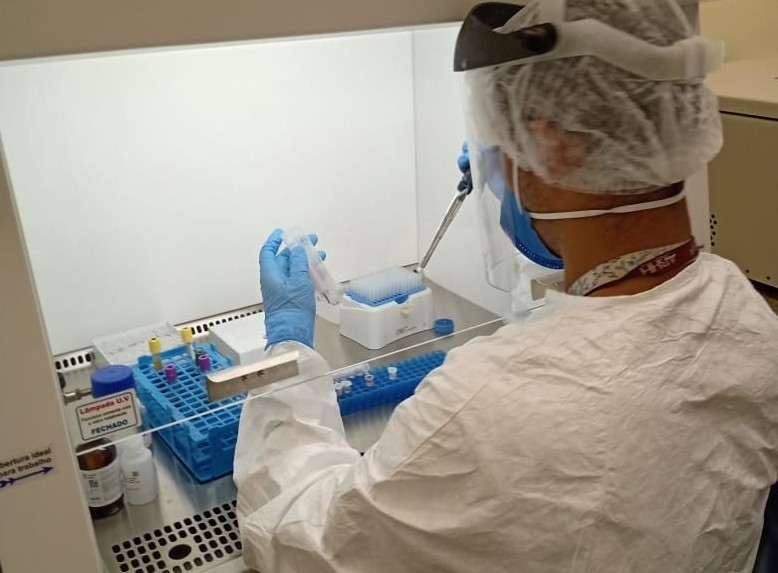


A study by researchers at the University of São Paulo showed that the blood serum of severe patients contained high levels of the neurotransmitter acetylcholine and lipid mediators derived from arachidonic acid. The discovery may help improve the prognosis of such patients and the treatment available to them (photo: ImunoCovid)
Published on 03/15/2021
By Maria Fernanda Ziegler | Agência FAPESP – Severe and fatal cases of COVID-19 are characterized by systemic inflammation leading to lung collapse as well as the failure of other organs. This exacerbated immune response to viral infection involving high blood levels of pro-inflammatory molecules, known as a cytokine storm, can cause more damage than the virus itself.
Researchers at the University of São Paulo (USP) in Ribeirão Preto and the Federal University of São Carlos (UFSCar), both in the state of São Paulo (Brazil), have shown for the first time that hyperinflammation of the lungs, the cytokine storm, and disease severity are associated with extremely high levels of arachidonic acid-derived lipid mediators and acetylcholine, the chief neurotransmitter in the parasympathetic nervous system.
FAPESP supported the study via a Regular Research Grant for a project focusing on biomarkers and novel therapeutic targets to combat COVID-19. The findings were reported on the preprint platform medRxiv, in a paper that has yet to be peer-reviewed.
“The high levels of these molecular components found in the blood of severe COVID-19 patients presumably means their lung cells and white [immune system] blood cells release acetylcholine, arachidonic acid and their derivatives, as well as cytokines. This is surprising, as no one has previously reported finding these lipid compounds in the lungs of COVID-19 patients,” said Lúcia Helena Faccioli, a professor in the University of São Paulo’s Ribeirão Preto School of Pharmaceutical Sciences (FCFRP-USP).
The study was part of a research line pursued by ImunoCovid, a multidisciplinary consortium of ten researchers at USP, one at UFSCar, and healthcare professionals at two Ribeirão Preto hospitals (Santa Casa de Misericórdia and Hospital São Paulo), collaborating on scientific research and sharing data and samples.
According to Faccioli, further studies are now possible on the participation of lipid mediators in this type of inflammation, in addition to biomarkers of COVID-19 severity and therapeutic targets.
Besides the two molecular components, the researchers detected a decrease in expression of immune cell membrane glycoproteins CD14 and CD36. They also found that administering glucocorticoids to treat inflammation only lowers levels of acetylcholine and does not affect arachidonic acid and derivatives.
“So although it’s beneficial for many patients, the use of corticoids to treat hyperinflammation doesn’t have the same results for all patients, Faccioli said. “Based on our findings in this study, the suggestion is that treatment with corticoids should begin as soon as possible for hospitalized severe and critical COVID-19 patients, in combination with arachidonic acid metabolism inhibitors.”
It should be stressed that improper use of corticoids can be harmful to the patient. Medical advice is essential regarding dosages and when to start and end the treatment. Using this type of medication without a prescription from a physician and during the early infection phase, which precedes the inflammatory phase, can make the patient’s condition worse.
Jigsaw puzzle
The study adds important pieces to the COVID-19 jigsaw puzzle, helping scientists understand how different molecules enter the cascade that becomes a cytokine storm. Research by a group at the same university’s Ribeirão Preto Medical School (FMRP-USP) had already pointed out the role played by an immune mechanism known as the inflammasome in this process (read more at: agencia.fapesp.br/34732).
Faccioli’s group used high-performance liquid chromatography coupled with mass spectrometry (LC-MS) to determine whether infection by SARS-CoV-2 altered lipid mediator metabolism, analyzing the lipidome (all plasma lipids) in samples from COVID-19 patients and healthy volunteers. A total of 8,791 metabolite features were present in at least 50% of the samples.
They next measured mediator levels in serum from 190 COVID-19 patients aged 16-97, of whom 43 were asymptomatic, 44 moderate, 54 severe, and 49 critical, stratifying them into four phases or degrees of infection (mild, moderate, severe, and critical). The control group comprised 39 healthy volunteers and 13 hospitalized non-COVID-19 patients (not infected).
The results were confirmed by an analysis of lung biopsy gene expression data from patients infected by SARS-CoV-2 in public repositories and scientific publications. More research is needed, but the findings open up new prospects for the treatment of COVID-19.
The article “Cholinergic and lipid mediators crosstalk in Covid-19 and the impact of glucocorticoid therapy” can be read at: www.medrxiv.org/content/10.1101/2021.01.07.20248970v1.
Source: https://agencia.fapesp.br/35096